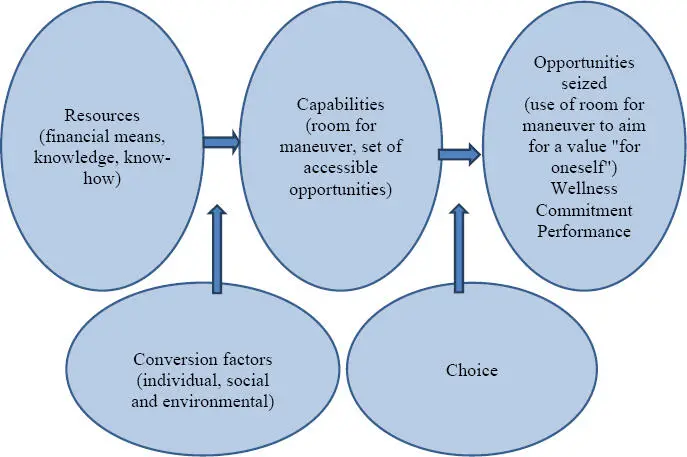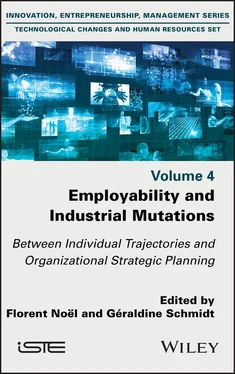2.1.3. Employability as an individual responsibility
Career paths are increasingly incorporating the hypothesis of negotiated mobility, in the image of the mutual agreement of termination which has largely replaced redundancies for economic reasons (Milin 2018). Moreover, public policies to combat unemployment are changing: safeguarding employment is becoming secondary, to the benefit of competitiveness, a guarantee of growth and employment. The objective is to strengthen the capacity of organizations to succeed in the face of change and, to this end, to enhance the mobility of individuals. Skills development systems are increasingly designed to serve evermore mobile careers. The emphasis placed on lifelong learning, the strengthening of financing methods outside the company, and the increased flexibility in the ways in which employment contracts are terminated are all part of this trend towards making individuals responsible for their own career paths.
Employability is then assessed in terms of the dynamism and quality of the career path, in a perspective similar to what Gazier calls “employability-performance”. From this perspective, employees are expected to be able to evolve, to be mobile and adaptable, and to be willing to make optimal use of their skills (Van der Heijde and Van der Heijden 2006; Fugate and Kinicki 2008).
2.1.4. Employability for the development of organizations and individuals?
Finally, the literature on the future of work predicts a decline in prescribed work, a shortening of production series, a development of project mode organization and design tasks to the detriment of execution tasks (Gilbert and Noël 2021). In a work environment that is increasingly intellectual and relational, the subjective commitment of employees is becoming a performance issue for organizations. Being employable means knowing how to evolve with one’s job or how to make one’s job evolve according to contextual constraints. Adaptation is becoming a recurring work situation, and employability a key skill.
In this shift from structuring work organization to permanent organizational work (Véro and Zimmermann 2018), the development of employability joins the ability of employees to contribute to the organization in a way that balances their personal aspirations with the organization’s need to meet production and customer requirements. Employability is as much about creating a job for oneself as it is about acquiring a pre-existing job (De Grip et al. 2004). The rhetoric of employability is then confused with that of the liberated enterprise or emancipatory work in the continuity of the learning organization models.
Table 2.1attempts to summarize these four conceptions of employability and tries to highlight the managerial problems as well as the management systems that can help to solve them.
Table 2.1. Concepts of employability and management issues
| Use of the concept |
Employability to include |
Employability to facilitate mobility |
Employability for flexibility |
Employability to develop |
| Responsibility |
Public authorities. |
Employer. |
Employee. |
Employer and employee. |
| Problem to solve |
Bringing “unemployable” workers to employment. Relieve the cost of social benefits. |
Facilitate mobility to facilitate restructuring. |
Organize boundaryless careers.Empowering employees in the management their careers. |
Personal development and well-being for the employee.Use the skills of employees to build the organization “along the way”. |
| Figure of the employable worker |
The worker declared fit to work. |
The skilled worker. |
The mobile worker. |
The contributor. |
| Types of devices |
Prevention of discrimination.Training upgrading.Exemption from job search. |
Workforce planning.Outplacement services.Internal mobility for internal mobility.Validation of skills. |
Personal training account.Advisor in professional development.Termination of contract. |
Participatory management.Building enabling environments. |
| Nature of the mutations |
Macro-economic changes (mass unemployment). |
Restructuring plans. |
Continuous workforce management. |
Development of individual and collective skills. |
| Nature of the employment relationship |
None, employability is an external issue to the organization. |
Subordination, the employer responsible for the employee. |
Market, the employee rents himself to the employer. |
Partnership, organization and employees develop together. |
At each stage of this migration of the concept, we encounter particular forms of organization, public or managerial management systems, linked to a set of constraints weighing on individuals. The use of the notion of employability is inseparable from the reflection on the career paths that need to be experienced (mobility, internal or external) or avoided (staying in the present situation). For employees, as for companies, it is a question of coping with change: the challenge is ultimately to “not remain on the sidelines” in a world in perpetual motion: to be able to seize opportunities thanks to a flexible workforce for companies and for employees, not to find oneself in a situation of professional deadlock, forced to remain in (or change to) a degrading or deteriorating situation.
Emphasizing the interactive dimension of employability leads, on a theoretical level, to a combination of agential dimensions (the role of individuals) and structural dimensions (the role of organizations and institutions). On a more operational level, this means that employability results from or is built on both elements relating to the individual and elements relating to the context in which he or she evolves (market(s), socio-cultural environment and organization). Employability is a set of resources and skills that are part of and built in a context (of work, organization, institutions, etc.) that “enables”, “facilitates” or “empowers”. This brings us back to the concept of “capability” developed by the economist and philosopher Amartya Sen, and taken up in this book by Bénédicte Zimmermann ( Chapter 3). From the company’s point of view, developing employability should ultimately lead to the dilution of antagonisms with employees regarding the changes at work by developing a form of empowerment of the latter with regard to their own path, which should lead to the formulation of choices that are of value for them, as well as for the company. Van der Klink et al. (2016) adopt this capability approach to explore the concept of employability from the perspective of individuals and their employers. They argue that “capabilities refer to the opportunities and ability to achieve valuable outcomes that a person has and that depend on personal characteristics and external factors: having the capabilities and being enabled”.

Figure 2.2. The Van der Klink et al. model (2016)
In order to do this, we need to take an interest, in accordance with the analytical grid proposed by Sen (2008), in the resources available to individuals, and also in the individual social or environmental conversion factors that enable them to effectively use these resources to develop their capabilities, that is, a set of opportunities whose spectrum is constitutive of the freedom actually offered by employability within which the individual will be able to make value choices. Figure 2.2summarizes the entire process.
Читать дальше













